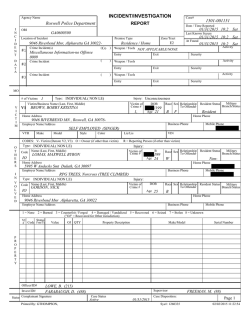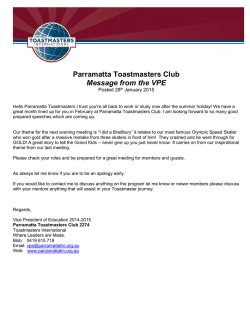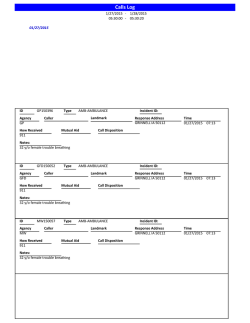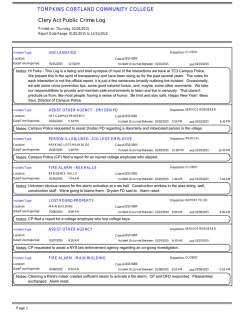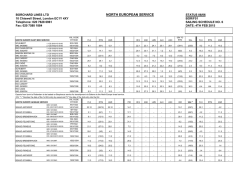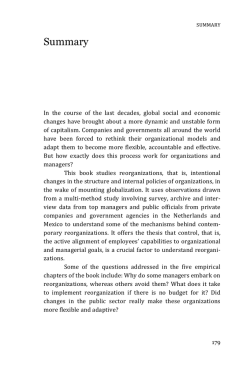
Operations Section Chief - Type 3 - All
POSITION TASK BOOK FOR THE POSITION OF Type 3 ALL-‐HAZARDS OPERATIONS SECTION CHIEF (OSC3-‐AH) Version: January 2015 “This position task book is for a direct entry position and includes tasks of the Division/Group Supervisor and Task Force/Strike Team Leader positions.” “An individual who is qualified in one or more of these subordinate positions can be recorded as having completed the associated task(s) in this position task book.” DISCIPLINE-‐SPECIFIC ENDORSEMENTS Discipline: ___________________________________ Discipline: ___________________________________ Discipline: ___________________________________ [Note: It is the intent of the AHIMTA to use these core competencies in conjunction with discipline specific endorsements which are being developed.] POSITION TASK BOOK ASSIGNED TO INDIVIDUAL’S NAME DUTY STATION PHONE NUMBER E-‐MAIL POSITION TASK BOOK INITIATED BY OFFICIAL’S NAME TITLE DUTY STATION PHONE NUMBER E-‐MAIL POSITION TASK BOOK WAS INITIATED LOCATION DATE Page 1 of 22 EVALUATOR DO NOT COMPLETE THIS UNLESS YOU ARE RECOMMENDING THE TRAINEE FOR CERTIFICATION VERIFICATION/CERTIFICATION OF COMPLETED POSITION TASK BOOK FOR THE POSITION OF: ALL HAZARDS OPERATIONS SECTION CHIEF TYPE 3 CORE COMPETENCIES FINAL EVALUATOR’S VERIFICATION I verify all tasks have been performed and are documented with appropriate initials. I also verify ________________________________________________________________________ has performed as a trainee and should therefore be considered for certification in this position. FINAL EVALUATOR’S SIGNATURE: DATE: EVALUATOR’S PRINTED NAME: TITLE: DUTY STATION: PHONE NUMBER: E-‐MAIL: CORE COMPETENCIES CERTIFYING OFFICIAL FOR CERTIFICATION I certify __________________________________________________________________________ has met all requirements for qualification in this position is certified for the position. OFFICIAL’S SIGNATURE: DATE: OFFICIAL’S NAME: TITLE: DUTY STATION: PHONE NUMBER: EMAIL: Page 2 of 22 VERIFICATION/CERTIFICATION OF COMPLETED POSITION TASK BOOK FOR THE ALL HAZARDS OPERATIONS SECTION CHIEF TYPE 3 ____________________ POSITION SPECIFIC COMPETENCIES FINAL EVALUATOR’S VERIFICATION I verify all tasks have been performed and are documented with appropriate initials. I also verify ________________________________________________________________________ has performed as a trainee and should therefore be considered for certification in this position. FINAL EVALUATOR’S SIGNATURE: DATE: EVALUATOR’S PRINTED NAME: TITLE: DUTY STATION: PHONE NUMBER: E-‐MAIL: _____________________ POSITION SPECIFIC COMPETENCIES CERTIFYING OFFICIAL FOR CERTIFICATION I certify ___________________________________________________________________________ has met all requirements for qualification in this position is certified for the position. OFFICIAL’S SIGNATURE: DATE: OFFICIAL’S NAME: TITLE: DUTY STATION: PHONE NUMBER: EMAIL: Page 3 of 22 NATIONAL INCIDENT MANAGEMENT SYSTEM (NIMS) INCIDENT COMMAND SYSTEM (ICS) POSITION TASK BOOKS (PTBs) Position Task Books (PTBs) are designed to be used by any individual (trainee) interested in becoming certified under the National Incident Management System (NIMS). The PTB’s are intended to be used to document experiences that indicate successful completion of tasks specific to an Incident Command System (ICS) position. The performance requirements for each position are associated with core ICS competencies, behaviors and tasks as suggested to the Federal Emergency Management Agency (FEMA) by a multi-disciplined, highly-experienced expert panel. Trainees are evaluated during this process by qualified evaluators, and the trainee’s performance is documented in the PTB for each task by the evaluator’s initials and date of completion. An Evaluation Record will be completed by all evaluators documenting the trainee’s progress after each evaluation opportunity. Successful performance of all tasks, as observed and recorded by an evaluator, will result in a recommendation to the “authority having jurisdiction” (of the trainee), that the trainee be certified in that position. Evaluation and confirmation of the trainee’s performance while completing all tasks will normally require more than one training assignment and several different evaluators. Incidents lasting several days may involve multiple evaluators. Tasks may be evaluated on incidents, in a classroom simulation, in training, HSEEP compliant functional and full scale exercises and exercises and in other work situations as long as there is a qualified evaluator. It is important performances be critically evaluated and accurately recorded by each evaluator. All tasks must be evaluated. The Interstate Incident Management Team Qualifications System [IIMTQS] Guide lists the definitions for trainee, evaluator, training officer and authority having jurisdiction Page 4 of 22 Responsibilities: 1. Authority having jurisdiction (AHJ): • Select trainees based on the needs of their organization or to fulfill their obligations to contribute to Incident Management Teams or other Mutual Aid agreements. • Provide opportunities for evaluation and/or making the trainee available for evaluation. 2. The Individual/ Trainee: • Reviewing and understanding instructions in the PTB. • Identifying desired objectives/goals whenever an opportunity for evaluation is recognized. • Providing background information to an evaluator. • Assuring the evaluation record is complete. • Completing all tasks for an assigned position within the timeframe allowed for that position. All tasks with an approval older than the allowed timeframe must be reevaluated. • Notifying the local AHJ /training officer when the PTB is completed, and obtaining a signature recommending certification. • Retaining the original PTB and provide a copy of the PTB to the appropriate individual/department to obtain a qualification from your agency. 3. Evaluator(s): • Being qualified and proficient in the evaluated position • Meeting with the trainee and determining past experience, current qualifications and desired objectives/goals. • Reviewing tasks with the trainee. • Explaining to the trainee the evaluation procedures that will be utilized and which tasks may be performed during the evaluation period. • Accurately evaluating and recording demonstrated performance of tasks. Dating and initialing completion of the task to indicate satisfactory performance. Unsatisfactory performance should also be documented. • Completing the Evaluation Form found at the end of each PTB. • Completing an Incident Personnel Performance Rating (ICS 225) form. 4. The Final Evaluator: • Being qualified and proficient in the position being evaluated. • Reviewing the trainee’s record to ensure completeness. • Signing the verification statement on page 2 of the PTB when all tasks have been initialed. • Ensuring all tasks have been completed within the three years prior to submission for final approval. Any task with an approval older than three years must be reevaluated and brought up to date. 5. Training Officer: • Providing the correct version of the PTB to the individual in order to document performance. • Explaining to the trainee the purpose and processes of the PTB as well as the trainee’s responsibilities. • Tracking progress of the trainee. • Identifying incidents or situations where the trainee may have evaluation opportunities. • Identifying and assigning an evaluator who can provide a positive experience for the trainee, when the evaluation opportunity is within the AHJ’s jurisdiction. • Receiving and filing documentation from the assignment. 6. AHJ Designee • Issuing the PTB to document task performance. • Explaining to the trainee the purpose and processes of the PTB, as well as the trainee’s responsibilities. • Tracking progress of the trainee. • Identifying incident evaluation opportunities. • Identifying and assigning an evaluator who can provide a positive experience for the trainee, and make an accurate and honest appraisal of the trainee’s performance. • Documenting the assignment. • Conducting progress reviews. • Conducting a closeout interview with the trainee and evaluator and assuring documentation is proper and complete. Page 5 of 22 Competencies, Behaviors and Tasks: Each Position Task Book lists the performance requirements (tasks) for specific positions set by the ICS competencies and behaviors (September 2007) recognized by FEMA’s National Integration Center and posted to the NIMS Resource Center Web site, http://www.fema.gov/emergency/nims/. There are numerous bullet statements listed under each task. The bullet statements are listed as guidelines/examples for the evaluator to follow to insure that the intent of the task has been completed. Not all bullet statements for a task are required to be completed if the overall intent of the task has been satisfied. Each task has a code associated with the type of training assignment where the task may be completed. Definitions for these codes are below. While tasks can be performed in any situation, they must be evaluated on the specific type of incident/event for which they are coded. Tasks coded I must be evaluated on an incident/event, and so on. Performance of any task on other than the designated assignment is not valid for qualification. If more than one code is listed, the task may be completed on any of the listed situations (e.g. If code I, O1 and O2 are listed, the task may be completed on any of the three listed). The evaluator should circle the evaluation code the task was evaluated at. O1 = Task can be performed on a Planned Event, HSEEP compliant or Full Scale Exercise with equipment deployment which is managed under the Incident Command System (ICS). Examples of exercises that may employ ICS include oil spill, search and rescue, hazardous material response, and fire. O2 = Task can be performed on an Exercise which is managed under the Incident Command System (ICS). Examples of exercises that may employ ICS include oil spill, search and rescue, hazardous material response, and fire. O3 = Training or Daily Job environment that tests knowledge/skills associated with the task. O4 = Task can be performed during an ICS course classroom environment that tests knowledge/skills associated with the task. I = Task must be performed on an incident, which is managed under the Incident Command System (ICS). Examples of incidents that may employ ICS include oil spill, search and rescue, hazardous material response, fire, or law enforcement incidents that may be emergency or non-emergency in nature. R = Rare events seldom occur and opportunities to evaluate Trainee performance in real settings are limited. Examples of rare events include accidents, injuries, vehicle and aircraft crashes. Through interviews, the evaluator may be able to determine if the trainee could perform the task in a real situation. Page 6 of 22 ALL-‐HAZARDS OPERATIONS SECTION CHIEF TYPE 3 (OSC3-‐AH) JANUARY 2015 Core Competency: Assume position responsibilities Description: Successfully assume role of Operations Section Chief and initiate position activities at the appropriate time according to the following behaviors. Behavior: Ensure readiness for assignment. EVALUATION EVALUATOR RECORD # TASK CODE 1. Obtain and assemble information and materials needed for kit. Kit assembled and prepared prior to receiving an assignment. Kit contains critical items needed for the assignment and items needed for functioning during the assignment. Kit is easily transportable. The basic information and materials needed may include, but is not limited to, any of the following: Reference Materials • References appropriate for the incident type and agencies involved. • Functional Guidelines relative to incident type (e.g. Agency guidance and/or functional guidelines). • Emergency Responder Field Operations Guide (ERFOG). • OSC Position manuals. • IMT contact information. Forms • ICS 201, Incident Briefing • ICS 209, Incident Status Summary • ICS 213, General Message • ICS 214, Activity Log • ICS 215, Operation Planning Worksheet • ICS 220 (as applicable), Air Operations Summary Worksheet • ICS 221, Demobilization Checkout • Agency specific forms appropriate to the function Supplies • Office supplies appropriate to the function • Maps I O1 O2 O3 O4 2. Arrive properly equipped at incident assigned location within acceptable time limits. I O1 O2 3. Check in according to receiving agency/organization guidelines. I O1 O2 Evaluate the numbered tasks ONLY. DO NOT evaluate bullets; they are provided as examples/additional clarification. Page 7 of 22 ALL-‐HAZARDS OPERATIONS SECTION CHIEF TYPE 3 (OSC3-‐AH) JANUARY 2015 Behavior: Ensure availability, qualifications and capabilities of resources to complete assignment. TASK CODE EVALUATION EVALUATOR RECORD # 4. Identify kind, type and number of resources required to achieve objectives. • Consider topography, weather, kinds and types of resources, resource availability and health and safety factors. • Calculate resources needed using mathematical calculations (where applicable) and the intuitive method. I O1 O2 O3 5. Order necessary personnel and equipment. I O1 O2 Behavior: Gather, update, and apply situational information relevant to the assignment. TASK CODE EVALUATION EVALUATOR RECORD # 6. Obtain complete information from dispatch upon activation. • Incident name. • Incident order number. • Request number. • Reporting location. • Reporting time. • Transportation arrangements/travel routes. • Contact procedures during travel (telephone/radio). I O1 7. Gather information necessary to assess incident assignment and determine immediate needs and actions. • Incident Commander’s name and agency /organization contact information. • Type of incident. • Current resource commitments. • Current situation. • Expected duration of assignment. • Topography. • Weather. I O1 O2 8. Obtain briefing from Agency Administrator/ outgoing Incident Commander. I O1 O2 • Receive Incident Commander’s ICS 201 (Incident Briefing). Receive special instructions. Evaluate the numbered tasks ONLY. DO NOT evaluate bullets; they are provided as examples/additional clarification. Page 8 of 22 ALL-‐HAZARDS OPERATIONS SECTION CHIEF TYPE 3 (OSC3-‐AH) JANUARY 2015 9. Obtain briefing from Incident Commander (May be one-‐on-‐one or an Incident Management Team (IMT) meeting.). • Receive Incident Commander’s priorities, goals and objectives for the IMT. • Receive Incident Commander’s priorities, goals and objectives for the incident. I O1 O2 10. Collect information from outgoing Operations Section Chief, initial Incident Commander or other personnel responsible for incident prior to your arrival. • Obtain status of incident and assigned resources. • Obtain status of existing operations section, including air operations if applicable. • Obtain information on special hazards or threats. • Order necessary personnel and equipment. I O1 O2 Behavior: Establish effective relationships with relevant personnel. TASK CODE EVALUATION EVALUATOR RECORD # 11. Establish and maintain positive interpersonal and interagency working relationships. • Local agencies. • Hosting unit. • Public. • Division/Group Supervisors. • Command and General Staff. I O2 O3 12. Create a work environment that provides mutual respect and equal opportunity for all personnel assigned to the incident. I O1 O2 O3 O4 Evaluate the numbered tasks ONLY. DO NOT evaluate bullets; they are provided as examples/additional clarification. Page 9 of 22 ALL-‐HAZARDS OPERATIONS SECTION CHIEF TYPE 3 (OSC3-‐AH) JANUARY 2015 Behavior: Establish organization structure, reporting procedures and chain of command of assigned resources. TASK CODE 13. Supervise and adjust operations organization and tactics as needed, based on changes in incident situation and resource status. • Ensure priorities and tactics are communicated and understood throughout the operations section. • Ensure health and safety procedures are established and maintained throughout the operations section. • Ensure any changes in priorities or tactics are communicated and understood. • Provide for functional and geographical supervision as needed. • Ensure effective use and coordination of all assigned resources. • Maintain appropriate span of control. • Establish staging areas as needed. I O1 O2 EVALUATION EVALUATOR RECORD # Behavior: Understand and comply with ICS concepts and principles. TASK CODE EVALUATION EVALUATOR RECORD # 14. Maintain appropriate span of control. I O1 O2 15. Demonstrate knowledge of ICS structure, principles, positions and ICS forms. I O1 O2 16. Understand scope, roles, responsibilities, jurisdiction and authority of responder agencies. I O1 17. Assure execution of appropriate administrative requirements (to I O1 O2 include documentation, ICS forms, personnel and equipment time records, performance ratings). Evaluate the numbered tasks ONLY. DO NOT evaluate bullets; they are provided as examples/additional clarification. Page 10 of 22 ALL-‐HAZARDS OPERATIONS SECTION CHIEF TYPE 3 (OSC3-‐AH) JANUARY 2015 Core Competency: Lead assigned personnel Description: Influence, guide and direct assigned personnel to accomplish objectives and desired outcomes in a rapidly changing, high-‐risk environment. Behavior: Model leadership values and principles. TASK CODE 18. Exhibit principles of duty. • • • • Be proficient in your job, both technically and as a leader. Make sound and timely decisions. Ensure tasks are understood, supervised and accomplished. Train and mentor assigned subordinates. 19. Exhibit principles of respect. • • • • Know your subordinates and look out for their well-‐being. Keep your subordinates informed. Build the team. Assign your subordinates in accordance with their capabilities. 20. Exhibit principles of integrity. • • • Know yourself and seek improvement. Seek responsibility and accept responsibility for your actions. Set the example. EVALUATION EVALUATOR RECORD # I O2 O3 I O2 O3 I O2 O3 Behavior: Ensure the safety, welfare, and accountability of assigned personnel. TASK CODE EVALUATION EVALUATOR RECORD # 21. Recognize potentially hazardous situations. I O1 22. Inform subordinates of hazards. I O1 23. Control positions and function of resources. I O1 24. Ensure special precautions are taken when extraordinary hazards exist. I O1 25. Ensure adequate rest is provided to all assigned personnel. I O1 Evaluate the numbered tasks ONLY. DO NOT evaluate bullets; they are provided as examples/additional clarification. Page 11 of 22 ALL-‐HAZARDS OPERATIONS SECTION CHIEF TYPE 3 (OSC3-‐AH) JANUARY 2015 26. Provide and support a hostile-‐free work environment. I O1 O2 O3 O4 27. Comply with agency/organization health and safety requirements. • Develop tactical plans based on health and safety consideration/guidelines. • Spot check tactical operations to ensure compliance with safety considerations. I O1 O2 Behavior: Establish work assignments and performance expectations, monitor performance and provide feedback. TASK CODE 28. Periodically evaluate resource status and tactical needs to determine if resource assignments are appropriate. (TASK MUST BE COMPLETED TWICE AS A MINIMUM ON TWO (2) DIFFERENT INCIDENTS/EVENTS) • Determine kind and number of resources required to complete tactics. • Assign single resources, task forces or strike teams depending on the needs of the Division/Group Supervisors. • Approve assembly and disassembly of strike teams and task forces. • Provide for functional and geographical supervision as needed. • Establish staging areas as needed. I O1 O2 29. Perform the duties of a Division or Group Supervisor according to the most current version of the Emergency Responder Field Operations Guide (ERFOG). • Implement assigned portions of the IAP. • Assign resources within the Division or Group. • Report on the progress or control of operations. • Report on status of resources within the Division or Group. I O1 O2 EVALUATION EVALUATOR RECORD # (REQUIRES TWO (2) EVALUATIONS) Evaluate the numbered tasks ONLY. DO NOT evaluate bullets; they are provided as examples/additional clarification. Page 12 of 22 ALL-‐HAZARDS OPERATIONS SECTION CHIEF TYPE 3 (OSC3-‐AH) JANUARY 2015 30. Perform the duties of a Strike Team or Task Force Leader according to the most current version of the Emergency Response Field Operations Guide (ERFOG). • Perform tactical assignments assigned to the Strike Team or Task Force. • Report on work progress and status of resources. • Maintain work records on assigned personnel. • Relay important information to the supervisor. I O1 O2 31. Prepare and discuss performance ratings with subordinates I O1 Behavior: Emphasize teamwork. TASK CODE 32. Establish cohesiveness among assigned resources. • Establish trust through open communication. • Require commitment. • Set expectations of accountability. • Bring focus to the team result. I O2 O3 EVALUATION EVALUATOR RECORD # Behavior: Coordinate interdependent activities. EVALUATION EVALUATOR RECORD # TASK CODE 33. Interact and coordinate with all other command staff, general staff and appropriate Unit Leaders. • Receive and transmit current and accurate information. • Communicate changes to the IAP or relevant plan. • Inform appropriate team members of significant changes in operations. • Ensure the Resources Unit Leader is advised of all changes in status of resources assigned to the operation. Keep status current. • Provide Situation Unit Leader operational status for ICS 209 (Incident Status Summary). I O1 O2 34. Ensure effective use and coordination of all assigned resources. I O1 35. Coordinate with the replacement Operations Section Chief. • Coordinate the preparation of the next operational period’s Incident Action Plan (IAP) or relevant plan. I O1 Evaluate the numbered tasks ONLY. DO NOT evaluate bullets; they are provided as examples/additional clarification. Page 13 of 22 ALL-‐HAZARDS OPERATIONS SECTION CHIEF TYPE 3 (OSC3-‐AH) JANUARY 2015 36. Coordinate with subordinates and provide Planning Section Chief a list of excess personnel, contract equipment, crews, miscellaneous personnel and other resources. List will include: • Kind and type. • Quantity. • Time/date of available release. • Review the list daily for accuracy ensuring all units are demobilized in a timely and complete manner. I O1 37. Coordinate with local response agencies (e.g., fire, EMS, law enforcement, public health, public works, etc.). • Secure property. • Traffic control. • Evacuation. • Volunteers. I O1 Core Competency: Communicate effectively Description: Use suitable communication techniques to share relevant information with appropriate personnel on a timely basis to accomplish objectives in a rapidly changing, high risk environment Behavior: Ensure relevant information is exchanged during briefings and debriefings. TASK CODE EVALUATION EVALUATOR RECORD # 38. Participate in the operational period briefing, particularly emphasizing tactical priorities and any special health and safety considerations and changes from the written IAP. I O1 39. Brief the relief Operations Section Chief. I O1 40. Debrief the Operations Section Chief you are relieving. I O1 41. Update Incident Commander on current accomplishments and/or problems. • Inform Incident Commander as soon as possible of problems and accomplishments. I O1 42. Participate in the Tactics meeting. I O1 43. Participate in Post Incident Analysis as necessary. I O1 44. Participate in after-‐incident review per agency/organization policy. I O1 • Performing the role of Operations Section Chief Evaluate the numbered tasks ONLY. DO NOT evaluate bullets; they are provided as examples/additional clarification. Page 14 of 22 ALL-‐HAZARDS OPERATIONS SECTION CHIEF TYPE 3 (OSC3-‐AH) JANUARY 2015 Behavior: Ensure documentation is complete and disposition is appropriate. TASK CODE 45. Ensure incident documentation is completed as required by the Incident Commander. • Submit incident narrative to Planning Section Chief. • Complete and submit ICS 214 (Activity Log) to Documentation Unit for each operational period. • Ensure all personnel and equipment time records are complete and have been submitted to the Time Unit Leader/ Equipment Time Recorder at the end of each operational period. • Complete ICS 220 (Air Operations Summary Worksheet) as necessary. • Complete and submit performance evaluations for Operations Section resources at conclusion of incident. I O1 EVALUATION EVALUATOR RECORD # Behavior: Gather, produce and distribute information as required by established guidelines and ensure understanding by recipient. TASK CODE EVALUATION EVALUATOR RECORD # 46. Prepare for and participate in strategy meetings. • Share and evaluate operational information with Incident Management Team (IMT) members. I O1 O2 47. Report unexpected occurrences (fires, incidents within an incident, accidents, political contacts, property loss or damage, etc.). • Obtain information about special hazards or threats from: - Subordinates. - Personal observation. - Other incident personnel. - Off-‐incident personnel. • Ensure standard information contains nature of event, location, magnitude, personnel involved (do not release names of victims or agency/organization on the radio), initial action taken; e.g., helicopter picking up injured, appropriate subsequent action. I O1 O2 Evaluate the numbered tasks ONLY. DO NOT evaluate bullets; they are provided as examples/additional clarification. Page 15 of 22 ALL-‐HAZARDS OPERATIONS SECTION CHIEF TYPE 3 (OSC3-‐AH) JANUARY 2015 Behavior: Communicate and ensure understanding of work expectations within the chain of command and across functional areas. TASK CODE EVALUATION EVALUATOR RECORD # 48. Ensure priorities and tactics are communicated and understood throughout the operations section. I O1 O2 49. Ensure any changes in priorities or tactics are communicated and understood. I O1 O2 Behavior: Develop and implement plans and gain concurrence of affected agencies and/or the public. TASK CODE EVALUATION EVALUATOR RECORD # 50. Participate in preparation of IAP or relevant plan. • Update team on current situation. • Determine tactical priorities for next operational period. • Determine tactics and work assignments for next operational period or periods. • Advise on current capabilities and limitations. • Determine additional/excess resources. I O1 O2 51. Complete operational portion of IAP as part of ICS 215 (Operational Planning Worksheet). • Establish branches, divisions/groups and staging areas. • Establish priorities for aviation operations, if necessary. I O1 O2 52. Participate in the preparation of other necessary relevant plans (e.g., evacuation plan, contingency plan). I O1 O2 Evaluate the numbered tasks ONLY. DO NOT evaluate bullets; they are provided as examples/additional clarification. Page 16 of 22 ALL-‐HAZARDS OPERATIONS SECTION CHIEF TYPE 3 (OSC3-‐AH) JANUARY 2015 Core Competency: Ensure completion of assigned actions to meet identified objectives Description: Identify, analyze and apply relevant situational information and evaluate actions to complete assignments safely and meet identified objectives. Complete actions within established timeframe. Behavior: Administer and/or apply agency policy, contracts and agreements. TASK CODE EVALUATION EVALUATOR RECORD # I O1 54. Participate in the development of an “Incident within the Incident I O1 55. Designate and request agreements as necessary. • Coordinate with Finance Section. I O1 53. Ensure assigned contracted resources meet contract specifications. • Take necessary action for those not meeting specifications. Plan” based on a potential incident that could occur during incident operations. • Review Team :Incident within an incident” procedures Behavior: Gather, analyze and validate information pertinent to the incident or event and make recommendations for setting priorities. TASK CODE 56. Evaluate and monitor current situation. • Determine if present plan of action will meet incident objectives. • Determine if the present plan is congruent with the incident strategic plan. • Identify problems and concerns (evacuation, sheltering, aviation safety, etc.). • Identify priorities and values to be protected (life, property, infrastructure, environment, etc.) • Advise Incident Commander and other appropriate incident management team personnel. I O1 O2 EVALUATION EVALUATOR RECORD # Behavior: Prepare clear and concise assessments regarding hazards, hazard behavior, weather and other relevant events. TASK CODE 57. Assist in completing and validate health and safety ICS 215A (Incident Action Plan Safety Analysis). I O1 O2 EVALUATION EVALUATOR RECORD # Evaluate the numbered tasks ONLY. DO NOT evaluate bullets; they are provided as examples/additional clarification. Page 17 of 22 ALL-‐HAZARDS OPERATIONS SECTION CHIEF TYPE 3 (OSC3-‐AH) JANUARY 2015 Behavior: Make appropriate decisions based on analysis of gathered information. TASK CODE EVALUATION EVALUATOR RECORD # 58. Personally observe and review current operations to prepare tactics for the next operational period planning meeting considering: • Resource status. • Situation status. • Weather. • Communications capability. • Environmental impact. • Resources to be protected. • Cost constraints. • Aviation capabilities, limitations. I O1 O2 59. Periodically evaluate resource status and tactical needs to determine if resource assignments are appropriate. • Determine kind and number of resources required to complete tactics. • Assign single resources, task forces or strike teams. • Assemble and disassemble strike teams and task forces. I O1 O2 Behavior: Take appropriate action based on assessed risks. TASK CODE 60. Ensure the Risk Management Process is established and maintained throughout the operations section. (TASK MUST BE COMPLETED TWICE AS A MINIMUM ON TWO (2) DIFFERENT INCIDENTS /EVENTS) I O1 O2 EVALUATION EVALUATOR RECORD # (REQUIRES TWO (2) EVALUATIONS) Behavior: Modify approach based on evaluation of incident situation. TASK CODE 61. Evaluate effectiveness of IAP or relevant plan and adjust as necessary. • Evaluate progress of operations based on situation reports and evaluations from operations personnel. • Estimate immediate and long-‐range operational resources and logistical requirements. • Order or release resources as needed, providing appropriate lead time. I O1 EVALUATION EVALUATOR RECORD # Evaluate the numbered tasks ONLY. DO NOT evaluate bullets; they are provided as examples/additional clarification. Page 18 of 22 ALL-‐HAZARDS OPERATIONS SECTION CHIEF TYPE 3 (OSC3-‐AH) JANUARY 2015 Behavior: Plan for demobilization and ensure demobilization procedures are followed. TASK CODE 62. Assist in development, approval, and implementation of Incident Demobilization Plan. • Consider demobilization early in the incident. • Coordinate with the Demobilization Unit/Planning Section Chief during development and implementation of Demobilization Plan. • Coordinate during development and implementation with local agency/organization concerning functional demobilization procedures. • Brief staff on demobilization responsibilities. • Ensure all units are demobilized in a timely and complete manner. • If required, complete ICS 221 (Demobilization Checkout) and turn in to the appropriate person. • Brief replacement if necessary. I O1 O2 EVALUATION EVALUATOR RECORD # Behavior: Transfer position duties while ensuring continuity of authority and knowledge and taking into account the increasing or decreasing incident complexity. TASK CODE EVALUATION EVALUATOR RECORD # 63. Coordinate the development, approval and implementation of transfer of duties when incident escalates/deescalates. • Consider transition early in the incident. I O1 O2 64. Determine time of transfer with replacement. I O1 O2 65. Communicate transfer of duties to assigned resources and command staff. I O1 O2 66. If necessary, coordinate with agencies about transfer of command back to local jurisdiction. I O1 O2 Evaluate the numbered tasks ONLY. DO NOT evaluate bullets; they are provided as examples/additional clarification. Page 19 of 22 INSTRUCTIONS FOR COMPLETING THE EVALUATION RECORD There are four separate blocks allowing evaluations to be made. These evaluations may be made on incidents, simulations in classroom or in daily duties, depending on what the position task book indicates. This should be sufficient for qualification in the position if the individual is adequately prepared. If additional blocks are needed, a page can be copied from a blank task book and attached. COMPLETE THESE ITEMS AT THE START OF THE EVALUATION PERIOD: Evaluator’s name, incident/office title, agency, and email: List the name of the evaluator, his/her incident position or office title, agency, and email. Evaluator’s home unit address and phone: Self-‐explanatory #: The number next to the evaluator’s name in the upper left corner of the evaluation record identifies a particular incident or group of incidents. This number should be placed in the column labeled “Evaluation Record #” on the PTB for each task performed satisfactorily. This number enables reviewers of the completed PTB to ascertain the qualifications of the different evaluators prior to making the appropriate sign-‐off on the PTB. Location of Incident/Simulation: Identify the location where the tasks were performed by agency and office. Incident Kind: Enter kind of incident; e.g., hazmat, wildland fire, structural fire, search and rescue, flood, tornado, etc. Complexity: Identify complexity of incident or sub-‐incident that the evaluation is for by Type. COMPLETE THESE ITEMS AT THE END OF THE EVALUATION PERIOD: Number and Type of Resources: Enter the number of resources and types assigned to the incident pertinent to the trainee’s task book position. Duration: Enter inclusive dates during which the trainee was evaluated. This block may indicate a span of time covering several small and similar incidents if the trainee has been evaluated on that basis; e.g., several initial response wildfires in similar fuel types. Recommendation: Check as appropriate and/or make comments regarding the future needs for development of this trainee. Date: List the date the record is being completed. Evaluator’s initials: Initial here to authenticate your recommendations and to allow for comparison with initials in the PTB. Evaluator’s relevant qualification: List your relevant qualification to the trainee position you supervised. Page 20 of 22 Evaluation Record #1 TRAINEE NAME TRAINEE POSITION Evaluator’s name: Email: Incident/office title & agency: Evaluator’s home unit address & phone: Name and Location of Incident or Situation (agency & area) Incident Kind (hazmat, tornado, flood, structural fire, wildfire, search & rescue, etc.) Number & Type of Resources Pertinent to Trainee’s Position Duration (inclusive dates in trainee status) Complexity Type 1, 2, 3 The tasks initialed and dated by me have been performed under my supervision in a satisfactory manner by the above named trainee. I recommend the following for further development of this trainee. ______ The individual has successfully performed all tasks for the position and should be considered for certification. ______ Not all tasks were evaluated on this assignment and an additional assignment is needed to complete the evaluation. ______ The individual was not able to complete certain tasks (comments below) or additional guidance is required. ______ The individual is severely deficient in the performance of tasks for the position and needs further training (both required and knowledge and skills needed) prior to additional assignment(s) as a trainee. Recommendations: ______________________________________________________________________________________ _______________________________________________________________________________________________________ Date: ____________________________ Evaluator’s initials: ________________________ Evaluator’s relevant qualification:___________________________________________________________ #2 Evaluator’s name: Email: Incident/office title & agency: Evaluator’s home unit address & phone: Name and Location of Incident or Situation (agency & area) Incident Kind (hazmat, tornado, flood, structural fire, wildfire, search & rescue, etc.) Number & Type of Resources Pertinent to Trainee’s Position Duration (inclusive dates in trainee status) Complexity Type 1, 2, 3 The tasks initialed and dated by me have been performed under my supervision in a satisfactory manner by the above named trainee. I recommend the following for further development of this trainee. ______ The individual has successfully performed all tasks for the position and should be considered for certification. ______ Not all tasks were evaluated on this assignment and an additional assignment is needed to complete the evaluation. ______ The individual was not able to complete certain tasks (comments below) or additional guidance is required. ______ The individual is severely deficient in the performance of tasks for the position and needs further training (both required and knowledge and skills needed) prior to additional assignment(s) as a trainee. Recommendations: ______________________________________________________________________________________ _______________________________________________________________________________________________________ Date: ____________________________ Evaluator’s initials: ________________________ Evaluator’s relevant qualification:_____________________________________________________ Page 21 of 22 Evaluation Record (Continuation Sheet) TRAINEE NAME #3 TRAINEE POSITION Evaluator’s name: Email: Incident/office title & agency: Evaluator’s home unit address & phone: Name and Location of Incident or Situation (agency & area) Incident Kind (hazmat, tornado, flood, structural fire, wildfire, search & rescue, etc.) Number & Type of Resources Pertinent to Trainee’s Position Duration (inclusive dates in trainee status) Complexity Type 1, 2, 3 The tasks initialed and dated by me have been performed under my supervision in a satisfactory manner by the above named trainee. I recommend the following for further development of this trainee. ______ The individual has successfully performed all tasks for the position and should be considered for certification. ______ Not all tasks were evaluated on this assignment and an additional assignment is needed to complete the evaluation. ______ The individual was not able to complete certain tasks (comments below) or additional guidance is required. ______ The individual is severely deficient in the performance of tasks for the position and needs further training (both required and knowledge and skills needed) prior to additional assignment(s) as a trainee. Recommendations: _____________________________________________________________________________________________ _____________________________________________________________________________________________________________ Date: ____________________________ Evaluator’s initials: ________________________ Evaluator’s relevant qualification:_____________________________________________________ #4 Evaluator’s name: Email: Incident/office title & agency: Evaluator’s home unit address & phone: Name and Location of Incident or situation (agency & area) Incident Kind (hazmat, tornado, flood, structural fire, wildfire, search & rescue, etc.) Number & Type of Resources Pertinent to Trainee’s Position Duration (inclusive dates in trainee status) Complexity Type 1, 2, 3 The tasks initialed and dated by me have been performed under my supervision in a satisfactory manner by the above named trainee. I recommend the following for further development of this trainee. ______ The individual has successfully performed all tasks for the position and should be considered for certification. ______ Not all tasks were evaluated on this assignment and an additional assignment is needed to complete the evaluation. ______ The individual was not able to complete certain tasks (comments below) or additional guidance is required. ______ The individual is severely deficient in the performance of tasks for the position and needs further training (both required and knowledge and skills needed) prior to additional assignment(s) as a trainee. Recommendations: _____________________________________________________________________________________________ _____________________________________________________________________________________________________________ Date: ____________________________ Evaluator’s initials: ________________________ Evaluator’s relevant qualification:_____________________________________________________ Page 22 of 22
© Copyright 2024
